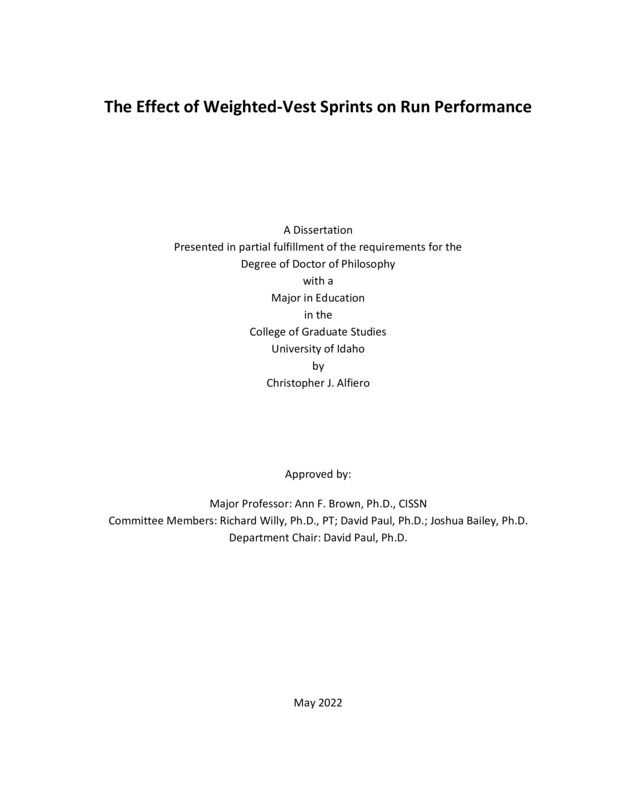The Effect of Weighted-vest Sprints on Run Performance.
Alfiero, Christopher. (2022-05). The Effect of Weighted-vest Sprints on Run Performance.. Theses and Dissertations Collection, University of Idaho Library Digital Collections. https://www.lib.uidaho.edu/digital/etd/items/alfiero_idaho_0089e_12299.html
- Title:
- The Effect of Weighted-vest Sprints on Run Performance.
- Author:
- Alfiero, Christopher
- Date:
- 2022-05
- Keywords:
- 1600-meter run performance GXT Middle-distance running Post-activation potentiation Weighted-vest
- Program:
- Education
- Subject Category:
- Physiology; Kinesiology
- Abstract:
-
Warm-ups are thought to acutely increase athletic performance by increasing blood flow, motor unit recruitment, and accelerating metabolism. Post activation potentiation (PAP) may be an underlying mechanism lending to an increase in athletic performance following a warm-up. PAP has been defined as the phenomenon by which muscular performance characteristics are enhanced because of muscle’s contractile history. An underlying physiological mechanism of PAP may be myosin regulatory light chain phosphorylation. There may be an acute effect of PAP on athletic performance, which is short in duration involving rapid, powerful movements. Although, PAP’s contribution to acute performance enhancement remains speculative, as other mechanisms (e.g., higher-order motor unit recruitment, increased leg stiffness, increased VO2 kinetics) may be at play. Thus, ‘pre-conditioning’ is used to encompass a multitude of physiological mechanisms contributing to improved sports performance. Several studies have provided evidence of pre-conditioning enhancing cycling and rowing performance; however, there is a paucity of data describing pre-conditioning’s efficacy on distance-running performance. Due to the elastic nature of running (i.e., reutilization of absorbed mechanical energy by leg muscles when contacting the ground) and possible acute increase in leg stiffness following pre-conditioning, incorporating resistance exercises into a distance running warm-up may benefit a distance running population. Thus, the primary purpose of the proposed study was to determine the effect of a pre-conditioning resistance exercise (i.e., PAP induction) on running performance in recreationally trained distance runners. A secondary purpose was to assess physiological parameters during a graded exercise test (GXT) on a motorized treadmill following a pre-conditioning resistance exercise. Seventeen recreational male distance runners (VO2peak ≥ 50ml∙kg-1∙min-1) were recruited for this study. The study was a counterbalanced crossover design requiring each participant to visit the laboratory on 5 separate occasions: Visit 1 – Familiarization and baseline testing; Visit 2 – Pre-conditioning with weighted vest or pre-conditioning with no additional weight followed by GXT; Visit 3 – Pre-conditioning with weighted vest or pre-conditioning with no additional weight followed by GXT; Visit 4 – Pre-conditioning weighted vest or pre-conditioning with no additional weight followed by 1600-m time trial (TT); Visit 5 – Pre-conditioning weighted vest or pre-conditioning with no additional weight followed by 1600-m TT. Visits measured the effect of a pre-conditioning loaded exercise, weighted-vest sprints (20% body mass), on 2 endurance running assessments (GXT treadmill run and a 1600-m max effort TT). Additionally, a control trial (pre-conditioning with no additional weight) was completed for each running assessment to identify the effect of pre-conditioning weighted-vest sprints. GXTs assessed VO2 kinetics (time constant and amplitude), submaximal VO2 (3.13, 3.58, 4.02, and 4.47 m·s-1), ventilatory thresholds 1 (VT1) & 2 (VT2), and peak oxygen uptake (VO2peak) via indirect calorimetry; resting lactate, lactate threshold (LT), onset of blood lactate accumulation (OBLA), and peak lactate via finger capillary blood samples; and leg stiffness (Kleg) via accelerometry on a motorized treadmill. The 1600-m TT assessed Kleg via accelerometry and running performance using time-to-completion and 400-m split times. All variables were analyzed with a repeated measures two-way ANOVA. Statistical analyses were performed with SPSS v.28. Data are reported as mean ± SD. Significance was accepted at p < 0.05. Submaximal VO2 at 3.13, 3.58, and 4.02 m·s-1 during the GXT was significantly decreased (p < 0.01 for all) following weighted-vest sprints compared to control. Resting lactate, and VT1 and VT2 were significantly greater following weighted-vest sprints compared to control (p < 0.05 for all). Time-to-completion during the 1600-m TT did not differ between warm-up conditions (p > 0.05). Weighted-vest sprints acutely improved submaximal running economy in recreationally trained distance runners but had no effect on middle-distance running performance during a 1600-m TT. Therefore, weighted-vest sprints may not be useful in improving middle-distance running performance, but may be utilized to improve running economy during submaximal run training.
- Description:
- doctoral, Ph.D., Education -- University of Idaho - College of Graduate Studies, 2022-05
- Major Professor:
- Brown, Ann F
- Committee:
- Willy, Richard; Bailey, Joshua; Paul, David
- Defense Date:
- 2022-05
- Identifier:
- Alfiero_idaho_0089E_12299
- Type:
- Text
- Format Original:
- Format:
- application/pdf
- Rights:
- In Copyright - Educational Use Permitted. For more information, please contact University of Idaho Library Special Collections and Archives Department at libspec@uidaho.edu.
- Standardized Rights:
- http://rightsstatements.org/vocab/InC-EDU/1.0/

